

64 Examples of Oxymorons in Sentences

Oxymorons are figures of speech in which two contradictory terms are combined in order to create a rhetorical effect by paradoxical means. The word oxymoron is derived from the Greek for pointedly foolish (oxys = sharp/keen and moros = foolish). Oxymorons are extremely useful in written English because they can make effective titles, add dramatic effect, add flavor to speech, and can sometimes be used to achieve a comedic effect. Here is a comprehensive list of 64 examples of oxymorons in sentences. In each example, the oxymoron is underlined.
Examples of Oxymorons in Sentences
- This is another fine mess you have got us into.
- There is a real love hate relationship developing between the two of them.
- Suddenly the room filled with a deafening silence .
- The comedian was seriously funny .
- You are clearly confused by the situation you have found yourself in.
- Her singing was enough to raise the living dead .
- Do you have the original copies that we requested?
- This is a genuine imitation Rolex watch.
- I really would like to try that new jumbo shrimp restaurant.
- His new girlfriend really is pretty ugly .
- Sorry, I can’t help you out right now, I am involved in my own minor crisis .
- Give me the fifty dollars you owe me or pay for dinner, it’s the same difference .
- My trip to Bali was very much a working holiday .
- I let out a silent scream as the cat walked through the door carrying a dead bird.
- You are going to have to use proofreading services, it is your only choice .
- The seventies was the era of free love .
- I will ask the professor for his unbiased opinion .
- The constant variable is the one that does not change.
- The sermon lasted for an endless hour .
- We laughed and cried through the tragic comedy.
- Parting is such sweet sorrow.
- They couldn’t wait to get out alone together.
- We’ll use plastic glasses at the picnic.
- The student teacher explained how to complete dissertation editing.
- The gossip is old news.
- The lady he eventually married is painfully beautiful .
- Wow! This ice cream is disgustingly delicious .
- Be careful in the playground, run slowly .
- Your apple pie is awfully good .
- A small crowd gathered to watch the concert.
- It’s an open secret that they have been having an affair for the past six months.
- He has a real passive aggressive personality.
- You were awfully lucky to escape the car crash unscathed.
- Stop being a big baby .
- I am sure I am growing smaller as I get older.
- She is my least favorite relation.
- The story was based on the concept of a true myth .
- That is an example of the typically weird behavior she continually demonstrates.
- He has become an extremely unpopular celebrity .
- I’m on a heavy diet until my wedding day.
- I am a deeply superficial person.
- I like a smuggler. He is the only honest thief .
- Good grief , we’re really late.
- I can’t make any promises but it’s a definite possibility .
- She was terribly pleased with her Birthday present.
- The army returned friendly fire as the enemy approached.
- He installed the new wireless cable in the television room.
- He was forced to stand down from his position as president.
- There will be zero tolerance in the future.
- I had no choice but to do what I was told.
Funny, Sarcastic and Cynical Oxymorons:
- Microsoft Works
- Military intelligence
- Government organization
- American history
- Business ethics
- Temporary tax increase
- Twelve-ounce pound cake
- Express Mail
- Marital bliss
- Congressional ethics
- Airline Food
- President Bush
- Peace Keeper Missile
Can you think of any examples of oxymorons in sentences? Leave a comment and share them with us all.
For more figurative language examples, see our guide to onomatopoeia .
112 thoughts on “64 Examples of Oxymorons in Sentences”
- Pingback: Language Arts Anchor Charts & Posters
How is “free love” an oxymoron?
the seventies of the era was free love
ahhhhhhhh funny!!!
wht are the different types of oxymoron
Happily Married! 😛
Love it! Thanks.
Does we have different types of oxymoron
- Pingback: What Are Oxymorons Examples | Windranger5
- Pingback: What Are Examples Of Complete Sentences | Windranger4
“oxymoron” is itself an oxymoron it means – clever foolishness.
Your an oxymoron….haha…anonymous….but you leave a photo!!
Political correctness has to be the biggest one of all! (or is it just a plain lie?)
Define a “good christian trump supporter”?
I watched the event from the dangerous safety of a tower
love is always an investment in another :—)
What abt bitter truf?
unconscious people are the living dead. Brain atrophy sets in as the brain is not used. Recovery is an erring process. The divine feeling of the promotion for servicing the queen and the social science of abduction, brake vandalism solitary confinement until property developers arrive. They do the pro motion together while divinely and scientifically opposed to the tango.
I’ve learnt something atleast
is uninvited guest an oxymoron?
Humane slaughter.
Common Sense (it’s so rare!!!)
She shouted! If my father were alive he’d turn in his grave at the sight of you ?
“Texas justice” (in the cynical category)
HAHAHAHHAHAH DYING
It would be similar to “morally superior hiLIARy supporter”.
I went for tech help. He spent the entire 30 minutes telling me what a good listener he was!
Liberal think tank.
(Golf) Metal wood
Is victim´s rights an oxymoron?
I really love this site cus it stirredup my brain immune system
Really helped me
is mere yard an oxymorn
Black is my favorite color.
Is “I disagree to agree” an oxymoron?
Is “I disagree to agree” an oxymoron??
Donald J Trump, President of the Divided States of America = Oxymoron
government worker and religious scholar
intellectual rubbish
Illegal immigrant. By definition, “immigrants” arrived in the destination country legally.
is heroic travesty an oxymoron
Just ACT NATURAL.
Problobly, Yeah it shuold
Can oxymorons be true
Don’t know
Depressed Gay
Informed Democrat
NICE answer!
My daughter must’ve been hungry last night; I gave her half a pizza and she ate the whole half!
Or that trump is a truthful liar.
Agnostic Christian.
The party was simply superb!
He was deadly calm
It’s you’re NOT your david
TRY to RELAX
I just bought a new antique!
I just bought a new antique
You need to know proper grammar if YOU’RE going to insult someone.
Semi permanent, more uniqe, most unique
To SHIVA : * DO we have not DOES we have.
* Do we have, not DOES we have.
Bitter sweet Lead Balloon plastic sliver wear negative income paper towel
Going up to the Downs
Religious Freedom
hhahahhahahhhhahahhahahahah
Boom roasted David
*cough* teachers pet *cough*
“Clean” coal
Good To Tatum… CIVILity is one extreme The bellicosity of WAR is the other extreme—- CIVIL WAR And To Chris: lol? Love it! INFORMED DEMOCRAT for the same reason. To Peppa: Nailed it!-BITTER SWEET: PLASTIC SILVERWARE: PAPER TOWEL: NEGATIVE INCOME and LEAD BALLOON. ✓: NEW AGE ::CASH FLOW (cynical) NEGATIVE CASH FLOW :: EUTHANASIA: eu=good thanatos= death. :: ✓FOOL’S GOLD ✓BLIND-SIGHTED :: PEACEFUL-RESISTANCE BURN-UP vs BURN-DOWN HERE TO ETERNITY SNOWBALL IN HELL TEARS OF JOY WALKING DEAD DEADMAN WALKING ICY HOT :: RAP MUSIC (sarcasm) BIG BOY & LITTLE MAN (WWII bomb) :: SMART BLONDE DULL ROAR :: ILLEGAL CITIZEN:: BRIDGE GAP. :: POWER OUTAGE:: PAYDIRT:: GOVERNMENT WORKER TAX BENEFIT :: BEAUTY MARK
That’s what I was thinking!!?
My comment has not been posted to where I was replying!!?
Conservative Democrat, Pop Punk, Silent Drums, CNN News, 2019/2020 Bipartisan President Impeachment, Soft Rock, Educated Guess, Honest Politician, Snops Fact Checking, Weather Forecast
She is regular irregular to the school
After a futile search, she turned up missing.
FACEBOOK PRIVACY
Daily Express readers
Positively melancholic
Washing one hand with the other
What about “of course not”?
Without doubt the Moor’s Murderers were ‘pure evil’.
liberal logic, critical acclaim and democratic socialism.
A socially-distanced get-together!
Customer Service
The “intellectual dark web”
deadly alive
Trump library
When in Rome (travel bans) I did, no I didn’t Beach Ball (as in formal dance, which you can not have on the beach, unless you got council permission, which would probably vary from state to state, country to country. You could google it for your local area. There’s one; in on)
@David Ransom: Your first one nailed it however, you don’t seem to have grasped the concept in your 2nd attempt. Nice try. Keep at it.
Can you put a piece of toast in the toaster for me?
- Pingback: What are the types of figurative language? - Improve Reading Skills
Ethical Hacking
- Pingback: Oxymoron - en.wikipedia.org - Logga In
I have the Oxymoron flu. It’s pretty ugly
Bruh it’s do we have
lmao poor david
‘You’re’ not ‘your.’ Your is possessive whereas you’re is an abreviation for you are.
Yeah uh… no.
??? I wondered the same thing ?
- Pingback: Best 23 Oxymoron Simple Definition - Edu Learn Tip
Leave a Comment
Definition of Oxymoron
Common examples of oxymoron, usage of oxymoron in speech or writing, famous oxymorons, difference between oxymoron and paradox, writing oxymoron.
Here are instances in which it’s effective to use oxymoron in writing:
Demonstrate Linguistic Skill
Enhance drama.
Oxymoron can enhance drama in writing. This is especially achieved if the word pairing reveals intensity or a great difference in quality. For example, if a character receives a painful smile, this creates a significant dramatic effect. Smiles are rarely associated with pain. Therefore, the reader is left in some suspense to wonder what events or feelings would result in such a response received by the character.
Create Humor
Indicate irony, examples of oxymoron in literature, example #1: romeo and juliet (william shakespeare).
Good night, good night! parting is such sweet sorrow , That I shall say good night till it be morrow.
Example #2: Don Juan (George Gordon, Lord Byron)
It is an awful topic–but ‘t is not My cue for any time to be terrific: For checker’d as is seen our human lot With good, and bad, and worse, alike prolific Of melancholy merriment, to quote Too much of one sort would be soporific;– Without, or with, offence to friends or foes, I sketch your world exactly as it goes.
In this poem , Lord Byron uses the oxymoron “melancholy merriment” to describe the feelings and connections between sadness and joy. This oxymoron is symbolic of the human condition as reflected in the poet’s mention of “our human lot.” In addition, this oxymoron supports and complements the balance of oppositions featured in the rest of the poem’s structure, such as good and bad, without or with, and friends or foes.
Example #3: Funeral Blues (W.H. Auden)
Stop all the clocks, cut off the telephone, Prevent the dog from barking with a juicy bone, Silence the pianos and with muffled drum Bring out the coffin, let the mourners come.
Example #4: The Catcher in the Rye (J.D. Salinger)
I’m the most terrific liar you ever saw in your life.
Related posts:
Post navigation.
What Is an Oxymoron? Definition and Examples
An oxymoron is a figure of speech that combines contradictory words with opposing meanings, like “old news,” “deafening silence,” or “organized chaos.” Oxymorons may seem illogical at first, but in context they usually make sense.
Oxymorons can be clearly confusing (see what we did there?), so this article explains everything you need to know. We’ll provide oxymoron examples and provide guidance on how they’re used, but first, let’s look at a more thorough oxymoron definition.
Here’s a tip: Want to make sure your writing shines? Grammarly can check your spelling and save you from grammar and punctuation mistakes. It even proofreads your text, so your work is extra polished wherever you write.
Your writing, at its best Grammarly helps you communicate confidently Write with Grammarly
Table of contents
What is an oxymoron, what is the purpose of oxymorons , oxymoron examples from literature, what is the difference between oxymoron and paradox , oxymoron faqs.
An oxymoron is a literary device that juxtaposes contradictory terms. Oxymorons are often used poetically as a way of bringing out a fresh meaning in a word or phrase. Like a paradox, an oxymoron is what’s known as a “contradiction in terms,” although oxymorons and paradoxes are two different things, as explained below.
The word oxymoron is an ancient Greek word, which translates most closely to something like “sharply dull” or “cleverly stupid .” In other words, the oxymoron definition is itself an oxymoron.
Oxymorons have been used for millennia. More than a few have even become commonplace expressions in modern-day English, such as these oxymoron examples:
- accurate estimate
- alone together
- awfully good
- bittersweet
- close distance
- grow smaller
- jumbo shrimp
- only option
- original copy
- passive-aggressive
- same difference
- seriously funny
- small crowd
- virtual reality
As with other literary devices like metaphor , onomatopoeia , and hyperbole , oxymorons have a few different purposes in writing, all of which are quite useful in the right situation:
Dramatic effect
As a contradiction of terms, an oxymoron both stands out and also elicits critical thinking. The reader must momentarily pause to comprehend and process the meaning—in other words, oxymorons make the reader think.
Oxymorons tend to have deeper meanings and be more memorable than noncontradictory words, so they work great at key points in your writing for boosting reader engagement. They also occasionally work well with figurative language to compound the power behind certain words.
Entertainment
Oxymorons present an ideal opportunity to be clever or funny. The inherent setup of contradictory words works great for jokes and other witty statements. Consider these oxymoron examples:
“I am a deeply superficial person.” —Andy Warhol
“I distinctly remember forgetting that.” —Clara Barton
Present words in a new way
Placing contrasting words next to each other makes each one stand out more, just like placing contrasting colors together. Highlighting their differences accentuates their meaning and the words come across stronger. That makes oxymorons a serious option in word choice .
Consider the oxymoron example deafening silence . On its own silence is fairly neutral—it can be calm or tense, depending on the context. But pairing it with deafening gives silence a very distinct meaning, comparing it to a loud noise that draws extra attention. This presents the word silence in a unique way that’s particularly expressive.
As rhetorical devices, oxymorons have been used in many different mediums from political speeches to novels to stage plays. (One, in particular, is in Romeo and Juliet by William Shakespeare, wherein “combining things that contrast” is an ongoing theme.) Here are some of the more famous oxymoron examples from historical literature:
“All the pain he had endured was as nothing compared with the exquisite agony of this.” —Jack London, The Call of the Wild
“The bookful blockhead, ignorantly read, With loads of learned lumber in his head . . .” — Alexander Pope, “An E ssay on Criticism”
“Of melancholy merriment, to quote.” —Lord Byron, Don Juan : Canto VIII
“His honour rooted in dishonour stood, And faith unfaithful kept him falsely true.” —Alfred, Lord Tennyson, Idylls of the King
“Parting is such sweet sorrow.” —William Shakespeare, Romeo and Juliet
“O brawling love! O loving hate!” — William Shakespeare, Romeo and Juliet
“A damned saint, an honorable villain!” — William Shakespeare, Romeo and Juliet
Oxymorons are often confused with paradoxes—after all, both are textbook contradictions of terms. Despite the similarities, however, oxymorons and paradoxes are two different types of literary devices, each with their own special usage.
We already gave an oxymoron definition above, so here let’s talk about paradoxes. A paradox is a statement that technically contradicts itself but remains true nonetheless. It may seem illogical or unrealistic, but, upon reflection, it’s based in reality and stems from valid reasoning. Consider these paradox examples:
“You have to spend money to make money.” “Slow and steady wins the race.” “I can resist anything but temptation.” —Oscar Wilde
The main difference between an oxymoron and a paradox is that oxymorons use contradictory words whereas paradoxes use contradictory ideas . An oxymoron is usually just two words (sometimes one, as in “bittersweet”), but a paradox is an entire statement, usually a standalone sentence or even a full paragraph .
By extension, oxymorons deal with the contrast between the meanings of words, but paradoxes focus on the contrast between complete ideas. The scope of a paradox can go much deeper, drawing on complicated themes and philosophical concepts. The scope of oxymorons, however, is limited only to the scope of the individual words used.
An oxymoron is a figure of speech that places contradictory terms next to each other in a word or phrase. As a literary device, it is used to make certain word combinations more thought-provoking to stand out.
What are some oxymoron examples?
Oxymorons are common in everyday speech. “Awfully good,” “bittersweet,” “same difference,” and “original copy” are a few oxymoron examples.
What is the difference between “oxymoron” and “paradox?”
Oxymorons combine contradictory words, but paradoxes combine contradictory ideas. Usually, oxymorons are made up of just two words, but paradoxes are complete sentences, sometimes entire paragraphs.

- Features for Creative Writers
- Features for Work
- Features for Higher Education
- Features for Teachers
- Features for Non-Native Speakers
- Learn Blog Grammar Guide Community Events FAQ
- Grammar Guide
50 Examples of Oxymorons

Krystal N. Craiker
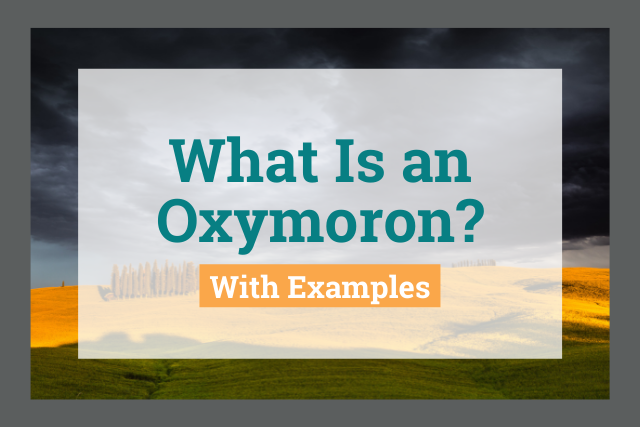
Do you know what an oxymoron is? No, it's not an insult!
An oxymoron is a common rhetorical device that combines two or more words with contradictory meanings into a single phrase.
They appear in literature and pop culture, and you probably use them all the time in your day-to-day life.
Today, we are taking a deep dive into the definition of this literary device . We'll also take a look at many fun and often funny examples of oxymorons.
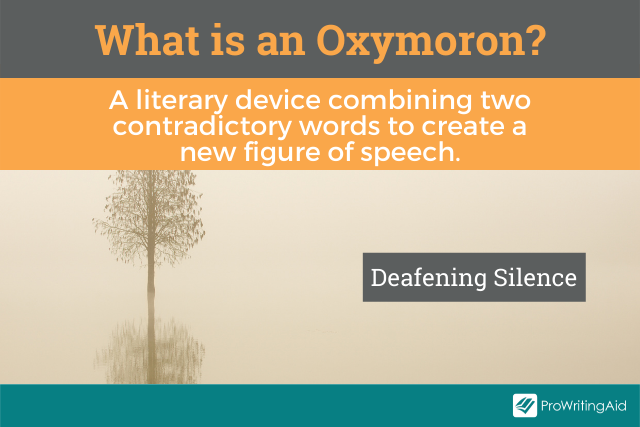
What Is an Oxymoron?
What are examples of oxymorons, what's the difference between oxymoron and paradox, what's the difference between oxymoron and irony, what's the difference between oxymoron and antithesis, what are some examples of oxymorons in literature, what are some examples of oxymorons in pop culture.
An oxymoron is a combination of words, typically just two words, with contradictory meanings. Even though the two words are often antonyms (words with opposite meanings), they don't negate each other.
However, if you think too hard about the meaning, you'll realize that on the surface it doesn't quite make sense.
When these words are combined, they create a figure of speech with a whole new meaning.
The word oxymoron is derived from a late-Greek word. In Greek, oxys means sharp or keen, and moros means foolish or dull. Together, oxymoros meant "pointedly foolish".
Now that we know the definition of oxymoron , let's take a look at some examples.
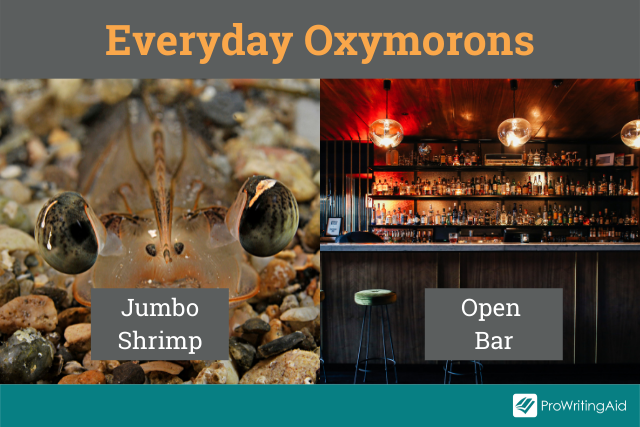
There are many oxymoron examples that you might come across in your everyday life. If you enjoy seafood, you might have tried jumbo shrimp .
Shrimp means small and jumbo means large, but when they are combined, this oxymoron just refers to larger-than-average shrimp.
When you order your jumbo shrimp, you might hope that there is an open bar .
This oxymoron means unlimited free drinks, but, by definition, a bar keeps something closed off—the opposite of open.
Have you ever played on an Oculus Rift? It's a virtual reality system.
Virtual reality is an oxymoron because "virtual" implies that something isn't real, but reality implies that it is. Together, these words mean a very realistic virtual world.

An elderly woman might talk about her adult children who live in a mobile home .
If you're in school to become an educator, you might have to spend a semester as a student teacher .
Or if you would prefer to get your master's degree, you'll be a graduate student .
My high school mascot was a stallion, so our female athletes were called the Lady Stallions . If you didn't know, a stallion refers to a male horse.
You might eat vegan bacon and fresh frozen fruit when you take a working vacation . Just try not to get freezer burn .
Even if you're a wise fool you can show real potential .
Maybe you've told a joke only to get deafening silence in response.
You'll also find examples in history and current events. You'll have definitely heard some in everyday conversation.
Countries engage in civil war or fight holy wars to defend those with blue blood .
On the nightly news, you might hear about an escaped prisoner or a controversy with a foreign national .
Perhaps a soldier was killed by friendly fire . Some of the stories might even be old news !
As a kid, you might have attended a slumber party where you played practical jokes on your friends.
You probably tried to act natural so no one would know what you were up to. We just hope you were never an uninvited guest !
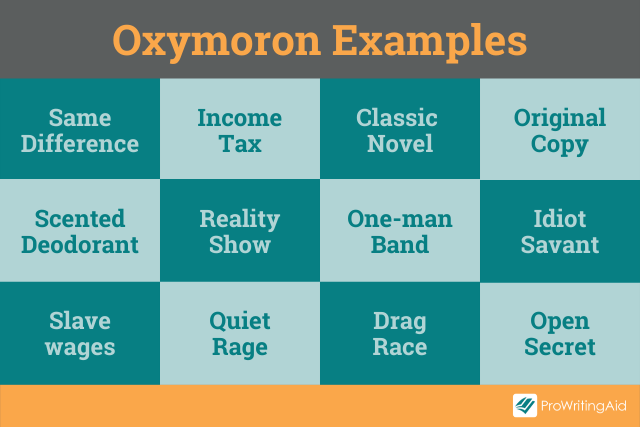
As you can see, there are tons of oxymorons in our lexicon. Here are a few more for your list:
- Same difference
- Terrible beauty
- Only choice
- Honest thief
- Silent scream
- Minor crisis
- Small crowd
Can you think of any other examples?
Do Oxymoron and Cliché Mean the Same?
Many oxymorons are so commonly used that they have become cliché. However, oxymorons themselves are not automatically clichés.
While they can be effective if used intentionally, clichés can make your writing feel stale and unimaginative.
ProWritingAid's Cliché check can help you identify them as they are easily overlooked.
In the below example, perhaps I could have said "aristocrats" or "high born", which both convey an identical meaning without being clichéd.
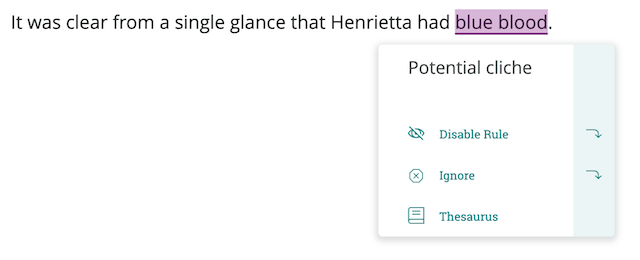
Try the Cliché Report with a free ProWritingAid account.
What Is an Oxymoron in Literature?
Oxymorons are often used in literature. As a literary device they can serve many functions. They can be used for emphasis, dramatic effect, or to highlight irony.
An oxymoron can confuse a reader intentionally, or paradoxically, it can offer clarity. It can be used for serious poignancy or for humor.

In short, an oxymoron is a versatile literary device . However, it's easily confused with other devices that involve contrast or contradiction.
An oxymoron uses opposing or contradictory terms to create a figure of speech.
A paradox is when two contrasting ideas are put together for the purposes of creating a comparison. At first, a paradox may not make sense, but it causes deeper reflection.
An example of a paradox in literature is from George Orwell's Animal Farm .
The quote "All animals are equal, but some animals are more equal than others" might appear true at first, but nothing can be more equal than something else.
It causes the reader to really think about the nature of equality.
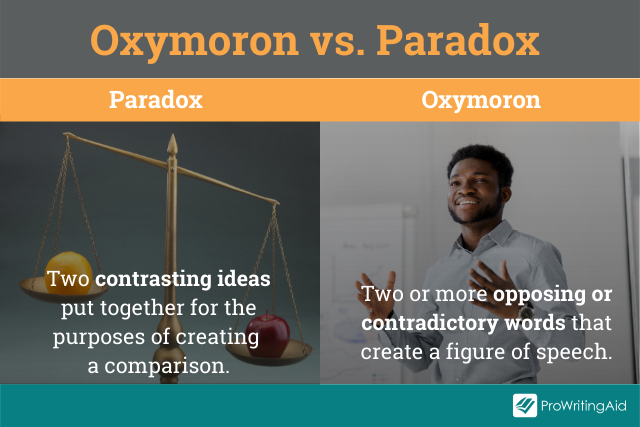
Irony is the difference between what a reader thinks should happen in a situation versus what is actually happening.
It plays with readers' expectations to demonstrate themes or build tension.
You might use an oxymoron to highlight irony, but irony isn't specifically related to a combination of words. It can also be more situational.
An example of dramatic irony comes from the play Oedipus Rex . Oedipus curses his father's killer, but he is unaware that he is actually his father's killer and has cursed himself.
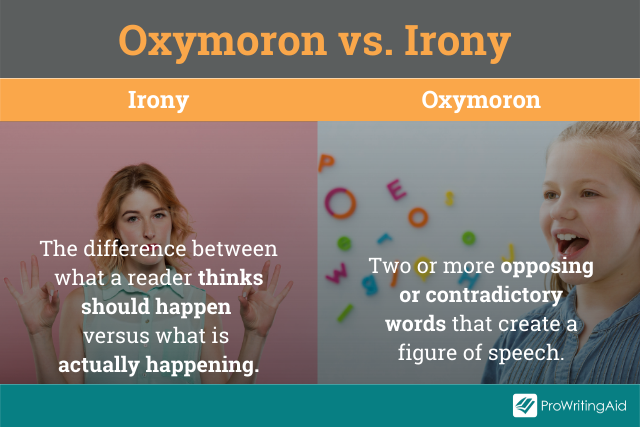
An antithesis also uses opposing words or phrases like an oxymoron, but it plays with syntax to create emphasis on an idea.
Antithesis isn't just one phrase. It uses parallel structure in conjunction with opposing or unrelated words.
William Shakespeare uses antithesis in this quote from Hamlet : "Give every man thine ear, but few thy voice; take each man's censure, but reserve thy judgment."
Each line uses parallel structure and contrasting ideas.
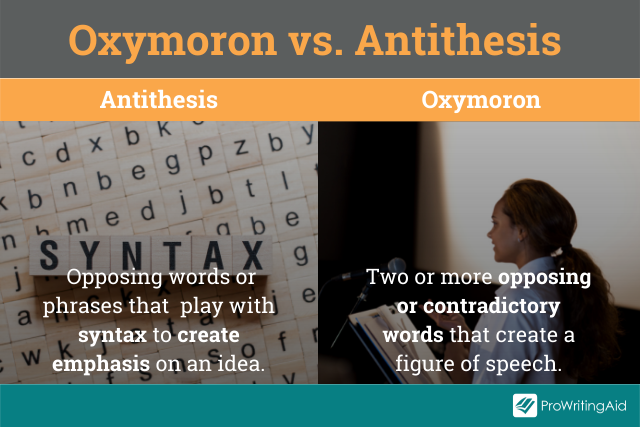
Oxymoron is used frequently in literature because it can serve so many functions. In fact, certain literary genres are oxymorons themselves.
Science fiction , magical realism , and historical fiction are all oxymoronic. These phrases combine to create a whole new concept.
Shakespeare was a master of using oxymoron in his plays and poems. There are several examples in Romeo and Juliet , like the following quotes.
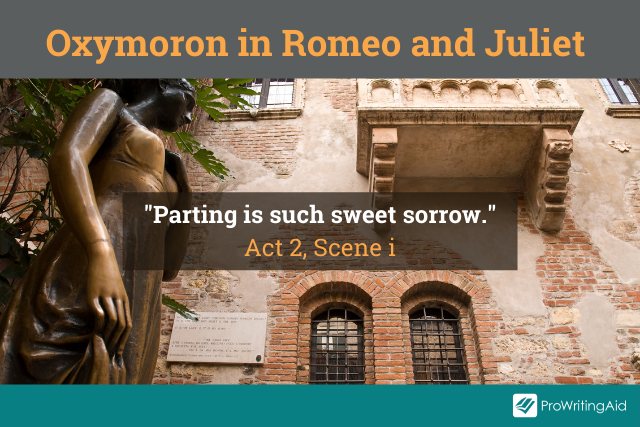
"Parting is such sweet sorrow ." Sorrow and sweet, while not directly antonyms, are contradictory in their connotations.
Here's a longer passage from the famous tragedy that uses multiple examples of oxymoron:
"Why, then, O brawling love ! O loving hate ! O anything, of nothing first create! O heavy lightness! Serious vanity ! Mis-shapen chaos of well-seeming forms ! Feather of lead , bright smoke , cold fire, sick health ! Still-waking sleep , that is not what it is! This love feel I, that feel no love in this."
In Animal Farm , George Orwell uses an oxymoron in the midst of a paradox: "All animals are equal, but some animals are more equal than others."
By definition, it is impossible for something to be more equal than another because equal means the same.
Alfred, Lord Tennyson uses three examples of oxymoron in one sentence in Idylls of the King . Here's the famous quote about Lancelot:
"His honour rooted in dishonour stood, And faith unfaithful kept him falsely true ."
It illustrates his dilemma in the story. To be loyal to King Arthur, his friend, he must betray his love Guinevere, or vice versa.
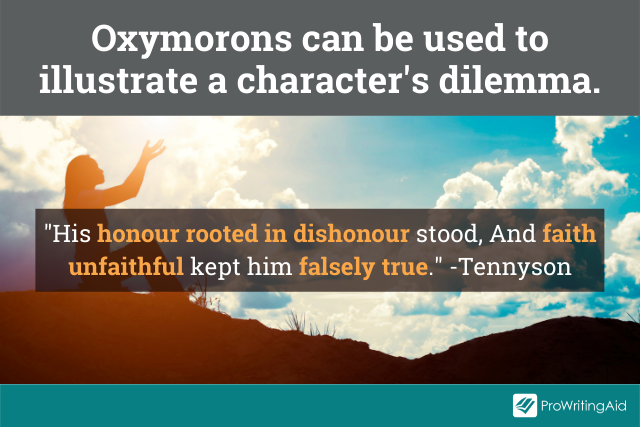
In Charlotte Brontë's classic Jane Eyre , St. John describes his love Rosamond as " delicious poison ".
Like the Tennyson example above, this oxymoron highlights St. John's dilemma in choosing between love and honor.
In Fairies and the Quest for Never Land , Gail Carson Levine describes the character Vidia as a " loyal traitor ".
Oxymorons aren't just for classic literature. Keep reading for some more modern examples.
Artist Andy Warhol once described himself as a deeply superficial person. Technically, one cannot be deep and superficial, as these words are opposites.
There are plenty of other oxymoron examples in pop culture. The book and HBO hit series Big Little Lies has an oxymoron right in its title. There is a book by Kirker Butler called Pretty Ugly .
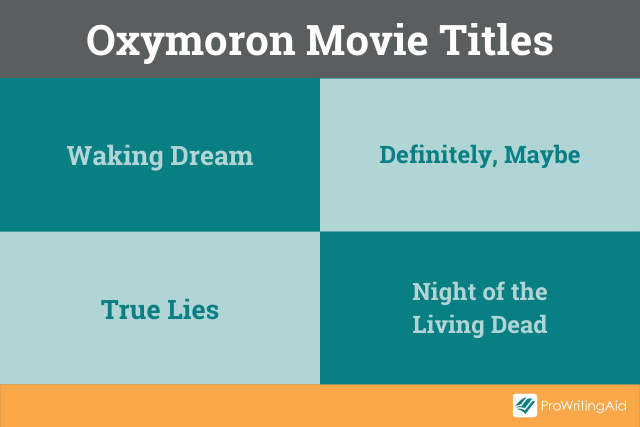
In 2018, a documentary about undocumented immigrants in the United States came out. It was called Waking Dream .
Hollywood hits Night of the Living Dead , True Lies , and Definitely, Maybe are all examples of oxymoron.
The John Legend song "All of Me" has a catchy verse with an oxymoron:
"All of me loves all of you
All your curves and all your edges
All your perfect imperfections ."
Nineties kids might remember the oxymoronic (and often outright moronic!) show CatDog .
Those same kids might have grown up to listen to Fall Out Boy's song " Alone Together " or Kelly Clarkson's " Beautiful Disaster ".
Their parents probably preferred Simon and Garfunkel's " The Sound of Silence " or the Beatles' " Hard Day's Night ".
In fact, the Simon and Garfunkel classic contains some powerful oxymorons in its lyrics:
"People talking without listening
People listening without hearing "
These are just a few oxymoron examples from pop culture. Listen for more examples from your music playlists or Netflix queue.
Dear reader, parting is such sweet sorrow, but hopefully now you understand how oxymorons take opposing words and turn them into new figures of speech.
From William Shakespeare to Fall Out Boy, you can see just how versatile oxymoron is as a literary device . Can you think of any more fun examples?
Take your writing to the next level:

20 Editing Tips From Professional Writers
Whether you are writing a novel, essay, article, or email, good writing is an essential part of communicating your ideas., this guide contains the 20 most important writing tips and techniques from a wide range of professional writers..

Be confident about grammar
Check every email, essay, or story for grammar mistakes. Fix them before you press send.
Krystal N. Craiker is the Writing Pirate, an indie romance author and blog manager at ProWritingAid. She sails the seven internet seas, breaking tropes and bending genres. She has a background in anthropology and education, which brings fresh perspectives to her romance novels. When she’s not daydreaming about her next book or article, you can find her cooking gourmet gluten-free cuisine, laughing at memes, and playing board games. Krystal lives in Dallas, Texas with her husband, child, and basset hound.
Get started with ProWritingAid
Drop us a line or let's stay in touch via :

Oxymoron Definition
What is an oxymoron? Here’s a quick and simple definition:
An oxymoron is a figure of speech in which two contradictory terms or ideas are intentionally paired in order to make a point—particularly to reveal a deeper or hidden truth. The most recognizable oxymorons are adjective-noun pairs, as in the phrase "proud humility." But oxymorons can also occur over the course of a clause or sentence, as in "That silence after your joke was deafening." In both examples, the oxymoron joins opposite ideas to make a point (such as that an awkward silence can have a presence comparable to a loud sound).
Some additional key details about oxymorons:
- The word "oxymoron" is itself an oxymoron. It comes from the Greek words oskús , meaning sharp or keen, and morōs meaning dull or foolish.
- If you're referring to oxymoron in plural, both oxymorons and oxymora are correct. Oxymorons is now more common in print than oxymora, but you'll find the latter listed in most dictionaries.
- The words in an oxymoron don't need to to be glued together, as in "heavy lightness" or "serious vanity." They can be spaced out, as in, "His honor rooted in dishonor stood," which is a line from Tennyson's "Lancelot and Elaine."
How to Pronounce Oxymoron
Here's how to pronounce oxymoron: ahk-see- mor -on
Oxymoron vs. Related Terms
Oxymoron is often confused with other related terms, such as "contradiction in terms," "paradox," and "antonym." Read on to find out how oxymoron is distinct from each of these terms.
Oxymoron vs. Contradiction in Terms
Today, many people use the term "oxymoron" as a synonym for any expression whose components contradict one another, even contradictions that are unintentional or come up in casual conversation (also called a "contradiction in terms"). However, an oxymoron is more specific than a contradiction in terms: it must be crafted intentionally in order to suggest that two contradictory ideas go together because their unlikely combination reveals a deeper truth.
For example, someone might (wrongly) call the phrase "business ethics" an oxymoron, simply to make the claim that business is always unethical. However, while it's possible to argue that "business ethics" is a contradiction in terms, the phrase is not an oxymoron. The beauty of an oxymoron is that it deliberately combines two words or ideas that contradict one another, not simply to point out how those ideas don't fit, but for the purpose of showing that a contradiction actually does make sense or reveal a deeper meaning.
For instance, a true oxymoron occurs when Juliet says to Romeo in Romeo and Juliet that "Parting is such sweet sorrow." Shakespeare has purposefully created this contradiction to capture the deeper truth of the simultaneous pain and joy of departing from a loved one—he's trying to communicate that being separated from your beloved is painful and yet, precisely because it's painful, parting reminds you of your love and joy.
To sum up, an oxymoron is not simply a contradiction in terms. A true oxymoron must be deliberately crafted in advance, with the goal of creating a rhetorical effect or revealing a deeper figurative meaning.
Oxymoron vs. Paradox
It's also helpful to understand the relationship between oxymoron and paradox. Both have to do with using contradiction to reveal deeper truths, but they differ in an important way: an oxymoron is a device, while a paradox is an idea.
A paradox is a concept that is simultaneously counterintuitive and truthful or revealing. Thus, an oxymoron might be a configuration of words that expresses a paradox, but the oxymoron is not, itself, the paradox. An example might help: the oxymoron "sweet sorrow" speaks to the paradox that love and pain can go together, but the oxymoron is not, in and of itself, the paradox that it expresses.
Oxymorons vs. Antonyms
Words that are antonyms have opposite meanings from one another. For example, "good" and "bad" are antonyms. Some people mistake pairs of antonyms for oxymorons, but they are not the same.
- Oxymorons take two contradictory words or ideas and bring them together to create a single, deeper meaning. The oxymoron "darkness visible," for instance, captures the sense of darkness being not just the lack of light, but also a tangible, terrible thing.
- Antonym pairs—such as good and bad, light and dark, or strong and weak—do not create a new, deeper meaning. Instead, each pair of words describes a range of possible traits on a spectrum, such as from good to bad, or from light to dark.
Oxymoron Examples
Oxymoron in prose.
Oxymorons can add color, humor, and meaning to language in all sorts of ways. Oxymorons are useful tools for authors and poets because they're based in contradiction, which makes them capable of describing complex or conflicting emotions.
Oxymoron in Shakespeare's Romeo and Juliet
Shakespeare used a great many oxymorons in his plays. Here's one more example from Romeo and Juliet . In these lines from Act 1, Scene 1, Romeo tells his cousin Benvolio about his feelings for a woman named Rosamund who doesn't love him back:
O heavy lightness, serious vanity, Misshapen chaos of well-seeming forms! Feather of lead, bright smoke, cold fire, sick health, Still-waking sleep, that is not what it is! This love feel I, that feel no love in this.
This cascade of oxymorons, placed one after the other, heightens the contrast between Romeo's idea of love and what he's actually experiencing. Because there are so many oxymorons, the paired words take on a clichéd tone that reflects on the quality of Romeo's "love" for Rosamund, which (we know from the title, "Romeo and Juliet") is fleeting and hasn't anything to do with the love affair that drives the rest of the play.
Oxymoron in Shakespeare's Macbeth
The following oxymoron occurs repeatedly throughout Macbeth . This first example is from the play's opening scene and it is part of a charm chanted by witches:
Fair is foul, and foul is fair: Hover through the fog and filthy air.
In this particular scene, the oxymoron "fair is foul, and foul is fair" speaks to the witches' evil character. They have an inverted moral code that values "the foul" and dislikes "the fair." On top of establishing the witches' cruelty, the line is also a signal to the audience to be on guard throughout the play—a warning that characters who seem fair may be foul, and vice versa. There's a drama and simplicity to the "fair is foul" oxymoron, which becomes a refrain as the play goes on and characters begin to act according to the witches' moral code.
Oxymoron in Vladimir Nabokov's Ada
Nabokov's novel Ada tells the story of Van and Ada, a sister and brother who meet as teenagers and fall in love, believing that they are cousins. In this example, Nabokov describes Ada, seen through Van's eyes, absorbed in one of her favorite activities:
On those relentlessly hot July afternoons, Ada liked to sit on a cool piano stool of ivoried wood at a white-oilcloth'd table in the sunny music room, her favorite botanical atlas open before her, and copy out in color on creamy paper some singular flower...Or else she combined one species with another (unrecorded but possible), introducing odd little changes and twists that seemed almost morbid in so young a girl so nakedly dressed.
The "nakedly dressed" oxymoron immediately follows the description of Ada's drawings, in which she combines together unlikely species: just as oxymorons conjoin unlikely words and ideas. The contradiction contained in "nakedly dressed" echoes the impossibility of the hybrids Ada draws, and more importantly, it expresses both Van's feeling that he can see into her soul despite the clothes covering her body, his yearning for her such that her clothes only suggest to him her body beneath them, and at the same time (because it's an oxymoron and the words contradict) the impossibility of the siblings' relationship. This example is similar to the lines above from Romeo and Juliet, in that both use the contradictory terms of an oxymoron to reflect the characters' experience of thwarted love.
Oxymoron in Ernest Hemingway's For Whom the Bell Tolls
These lines from Chapter 7 of For Whom the Bell Tolls describe an encounter between Robert Jordan, a young American soldier fighting in the Spanish Civil War, and his lover María.
She held herself tight to him and her lips looked for his and then found them and were against them and he felt her, fresh, new and smooth and young and lovely with the warm, scalding coolness and unbelievable to be there in the robe that was as familiar as his clothes, or his shoes, or his duty and then she said, frightenedly, “And now let us do quickly what it is we do so that the other is all gone.”
The couple's relationship becomes a bright spot for both of them in the midst of war, but ultimately also a source of pain and confusion for Jordan, as he struggles to balance his obligation to fight with his desire to live happily by Maria's side. The contradiction contained within the oxymoron "scalding coolness" emphasizes the couple's conflicting emotions and impossible situation.
Oxymoron Examples in Poetry and Song Lyrics
Oxymoron in alfred lord tennyson's "lancelot and elaine":.
The following lines refer to Lancelot, who is in love with Guinevere, King Arthur's wife. In the poem, Lancelot is tempted by another woman, but he remains "true" to Guinevere.
The shackles of an old love straitened him, His honour rooted in dishonour stood, And faith unfaithful kept him falsely true.
The sequence of oxymorons in this example (honour/dishonour, "faith unfaithful," "falsely true") emphasizes the contrast between Lancelot's "faithful" love for Guinevere, and the fact that his relationship with Guinevere makes them both unfaithful to Arthur.

Oxymoron in "The Sounds of Silence" by Simon and Garfunkel:
Paul Simon wrote the song The Sounds of Silence about the difficulty people have in communicating with one another, but the lyrics were later interpreted as a reference to the Vietnam War (a war that many would say was full of contradictions):
Hello darkness, my old friend I've come to talk with you again Because a vision softly creeping Left its seeds while I was sleeping And the vision that was planted in my brain Still remains Within the sound of silence
Why Do Writers Use Oxymorons?
Some of the greatest truths lie in contradiction, and oxymoron is one of the best figures of speech for expressing contradiction. For example, as we covered above, Shakespeare used oxymorons to describe strong, opposing emotions that often occur together, and also to show how the friction between those two feelings—love and hate, or love and pain, for example—can coexist and shape characters' experiences. However, oxymorons aren't always so serious. The following example is from Alexander Pope's poem, "Essay on Criticism":
The bookful blockhead ignorantly read, With loads of learned lumber in his head, With his own tongue still edifies his ears, And always list’ning to himself appears.
In this case, the oxymorons "bookful blockhead" and "learned lumber" add humor and spice to Pope's writing. Even so, Pope uses oxymoron to emphasize that people who are well-read are not necessarily original thinkers.
Other Helpful Oxymoron Resources
- The Wikipedia Page on Oxymoron: A very thorough explanation which also discusses the use of oxymorons for comedic effect.
- The Dictionary Definition of Oxymoron: A basic definition and etymology of the term.
- Oxymoron List: An extensive list of oxymorons and paradoxes, also the online home-base for an international community of oxymoron-lovers. Note: many of these examples are actually contradictions in terms and not actual oxymorons, but it's still a helpful resource if you pick and choose carefully.

- PDFs for all 136 Lit Terms we cover
- Downloads of 1956 LitCharts Lit Guides
- Teacher Editions for every Lit Guide
- Explanations and citation info for 41,253 quotes across 1956 books
- Downloadable (PDF) line-by-line translations of every Shakespeare play
- Figure of Speech
- Common Meter
- Personification
- Formal Verse
- Polysyndeton
- Climax (Figure of Speech)
- Climax (Plot)
- Connotation

Literary Devices
Literary devices, terms, and elements, definition of oxymoron, difference between oxymoron and paradox, common examples of oxymoron.
There are many examples of oxymoron that have become common phrases, such as:
Other languages have contributed oxymora to English, such as the Chinese concept of yin-yang. The famous black and white circular symbol that expresses yin-yang shows a drop of white in the black and side and, conversely, a small bit of black in the white side. This is meant to represent that even opposites contain a bit of each other. The yin-yang symbol is thus also a visual representation of oxymoron.
Significance of Oxymoron in Literature
Examples of oxymoron in literature.
Alas, that love, whose view is muffled still, Should, without eyes, see pathways to his will! Where shall we dine?—O me! What fray was here? Yet tell me not, for I have heard it all. Here’s much to do with hate but more with love. Why then, O brawling love, O loving hate, O anything of nothing first created! O heavy lightness, serious vanity, Misshapen chaos of well-seeming forms! Feather of lead, bright smoke, cold fire, sick health, Still-waking sleep, that is not what it is! This love feel I, that feel no love in this.
Shakespeare used many oxymoron examples in his works, and his famous tragic play Romeo and Juliet contains several oxymora. In just this one short excerpt there are many oxymora back to back. For instance, “loving hate,” “heavy lightness,” “feather of lead,” “bright smoke,” “cold fire,” and “sick health” are all oxymoron examples. So too are the slightly longer lines, “O anything of nothing,” “Misshapen chaos of well-seeming forms,” and “This love feel I, that feel no love in this.” The interesting function of these many oxymora is to illustrate the difficult dualities of love and the extremes that a person may feel when in love. The theme of Romeo and Juliet is, of course, that of tragic love and the very relationship of the two lovers is an oxymoron, as Juliet states, “My only love sprung from my only hate!”
Down the close darkening lanes they sang their way To the siding-shed, And lined the train with faces grimly gay. Their breasts were stuck all white with wreath and spray As men’s are, dead.
(“The Send-Off” by Wilfred Owen)
As for believing things, I can believe anything, provided that it is quite incredible.
All animals are equal, but some animals are more equal than others.
In George Orwell’s famous satire Animal Farm , the animals kick out the human owners and attempt to govern the farm themselves. At first, the leader Napoleon creates seven commandments for them to follow, the most important of which is “All animals are equal.” However, as time goes on the commandments begin to change, just as Napoleon’s demeanor toward the rest of the animals starts to change. Eventually he changes this key commandment to the quote above: “All animals are equal, but some animals are more equal than others.” Of course, this new commandment is one of many examples of oxymoron in the new leadership system. Some animals being “more” equal than others is not actually possible if one is to believe the first half of the statement. Orwell used this quote precisely to highlight the hypocrisies of the Russian Revolution. He wrote Animal Farm to critique the form of communism adopted in Russian after the revolution, showing that there was, indeed, no real equality in the new system.
Test Your Knowledge of Oxymoron
2. Which of the following statements is an oxymoron example? A. Deliberate mistake B. Rotten banana C. Foolish idiot [spoiler title=”Answer to Question #2″] Answer: A is the correct answer. A mistake, by definition, is something that a person does not mean to do, while being deliberate is the opposite. However, one can imagine how this situation might arise, such as if an embezzler makes a “mistake” in the accounting so as to confuse the flow of funds.[/spoiler]
4. Which of the following lines from Shakespeare’s “Sonnet 72” contains an example of oxymoron? A. For you in me can nothing worthy prove B. Unless you would devise some virtuous lie C. My name be buried where my body is [spoiler title=”Answer to Question #4″] Answer: B is the correct answer, as a “virtuous lie” is an oxymoron.[/spoiler]

Choose Your Test
Sat / act prep online guides and tips, 60 easy oxymoron examples + analysis.
General Education
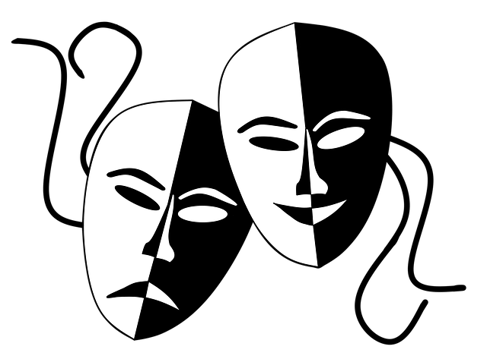
Despite what it might sound like, no—an oxymoron isn’t something you can call your little brother when he’s bugging you. Rather, an oxymoron is a cool literary device you can use in your creative writing.
We’ll go over exactly what an oxymoron is and then show you four oxymoron examples from pop culture and literature. We’ll also provide you with an extensive list of oxymorons so you can get a better feel for what oxymorons look and sound like.
What Is an Oxymoron?
An oxymoron is a figure of speech that combines two seemingly contradictory or opposite ideas to create a certain rhetorical or poetic effect and reveal a deeper truth. Generally, the ideas will come as two separate words placed side by side. The most common type of oxymoron is an adjective followed by a noun.
One oxymoron example is "deafening silence," which describes a silence that is so overpowering it almost feels deafening, or extremely loud—just as an actual sound would.
Oxymorons are often used in everyday conversation and in a breadth of writing, such as literature, poetry, and songwriting.
You might’ve heard of another literary device called the paradox , which is similar but not identical to the oxymoron. While an oxymoron is the combination of two contradictory/opposite words in a single sentence, a paradox is an entire phrase/sentence that appears contradictory but, upon further investigation, could be true or plausible.
One of the most famous examples of a paradox is the sentence, "This statement is false." If this statement is indeed false as it says, then this would actually make it true. But if the statement is true, then it can’t be false, despite the fact it claims to be!
Now, don't let your brain start to hurt just yet —up next, we take a look at oxymoron examples in sentences from literature and pop culture.
4 Oxymoron Examples + Analysis
Now that we’ve gone over what an oxymoron is, let’s take a closer look at four famous oxymoron examples in sentences to better understand how this literary device actually works.
Note: All bold emphasis in the following quotations is my own.
Oxymoron Example 1
This famous quotation from Shakespeare’s Romeo and Juliet contains an equally famous oxymoron.
In this scene, Juliet utters the phrase "sweet sorrow" to describe the feeling she has when having to say goodbye to Romeo. Although the adjective "sweet" evokes a giddy, romantic emotion, the word "sorrow" calls to mind the much less happy, far more depressing aspect of having to bid farewell to someone you'd rather not leave.
Thus, as the oxymoron suggests, this scene is happy since Juliet and Romeo are in love, yet it's also sad because they must say goodbye and cannot stay together through the night.
Oxymoron Example 2
— William Butler Yeats, "Easter 1916"
This excerpt from Irish poet William Butler Yeats’ famous poem "Easter 1916" has the prominent oxymoron "terrible beauty," which is repeated again at the end of the poem.
The main topic of this poem is the 1916 Easter Rising in Dublin , an event during which numerous Irish nationalists rebelled against the British government in Ireland. The violent display ultimately led to thousands of deaths and injuries.
Despite the "terrible" things that happened and the many lives lost, Yeats uses the term "beauty" to bring attention to the positive ideals of independence that gained ground as a result of this event: this desire for self-government is what spurred the Irish War of Independence just a few years later.
In this sense, the uprising was simultaneously terrible (in that it led to death) and beautiful (in its romantic aspirations for independence).

Oxymoron Example 3
— Alfred, Lord Tennyson, "Lancelot and Elaine" in Idylls of the King
This stanza, from Lord Tennyson’s retelling of the tale of King Arthur, uses several oxymorons for poetic effect and as a way to emphasize the conundrum that Lancelot, Arthur’s most loyal knight and friend, finds himself in.
The oxymorons here point to Lancelot's contradictory existence in regard to his relationships with both Guinevere and King Arthur: Lancelot is a "faithful" and "honorable" lover to Guinevere yet also an "unfaithful" and "dishonorable" knight to King Arthur, Guinevere’s husband, whom he is essentially betraying by carrying out a love affair with the queen.
Oxymoron Example 4
— John Legend, "All of Me"
These lines come from the hit 2013 song "All of Me" recorded by John Legend. The lyrics of this powerful piano ballad make use of several oxymorons.
With the first oxymoron, "p erfect imperfections," the speaker is making it clear that his lover’s flaws are ultimately what make her the perfect partner for him. The other two oxymorons emphasize the fact that no matter what happens —for example, no matter how sad or defeated the speaker might feel — there will always be a silver lining in that he's with the love of his life.

List of 50+ Oxymorons You Can Use
Below, we provide you with an extensive list of oxymorons. These 50+ oxymoron examples are listed alphabetically and arranged by category (i.e., the type of oxymoron word combination).
Feel free to look through this vast list of oxymoron examples if you’re in need of an oxymoron for something you're writing or if you simply want to learn some of the most common ones.
Single-Word & Compound-Word Oxymorons
- Bittersweet
- Frenemy (friend + enemy)
Adjective + Noun
- Bigger/larger half
- Controlled chaos
- Crash landing
- Cruel kindness
- Deafening silence
- Definite possibility
- Deliberate mistake
- Exact estimate
- Foolish wisdom
- Friendly fire
- Friendly foe
- Hateful love
- Heavy lightness
- Honest thief
- Living dead
- Loud whisper
- Loving hate
- Open secret
- Organized chaos
- Original copy
- Peaceful war
- Perfect imperfections
- Random order
- Same difference
- Silent scream
- Sweet misery
- Sweet sorrow
- Terrible beauty
- Unbiased opinion
- Virtuous lie
- Wakeful sleep
- Walking dead
- Working holiday/vacation
Adverb + Adjective/Adverb
- Alone together
- Awfully good
- Definitely undecided
- Falsely true
- Painfully beautiful
- Perfectly imperfect
- Seriously funny
- Strangely familiar
- Strangely normal
- Terribly good
- Truly false
Miscellaneous
- Act naturally
- Agree to disagree
- Kill with kindness
- Make haste slowly
What’s Next?
Want to learn more about figures of speech, besides oxymorons and paradoxes? Then check out our in-depth guide to the 31 literary devices you must know .
Oxymorons are an excellent, thought-provoking tool to use in writing, but they're certainly not the only device you should work with. Learn all about effective imagery and what personification is with our expert guides.
Preparing to take the AP Literature test? Then you'll need to know what to expect on exam day , including what kinds of questions you'll be asked and how much time you'll have.

Hannah received her MA in Japanese Studies from the University of Michigan and holds a bachelor's degree from the University of Southern California. From 2013 to 2015, she taught English in Japan via the JET Program. She is passionate about education, writing, and travel.
Ask a Question Below
Have any questions about this article or other topics? Ask below and we'll reply!
Improve With Our Famous Guides
- For All Students
The 5 Strategies You Must Be Using to Improve 160+ SAT Points
How to Get a Perfect 1600, by a Perfect Scorer
Series: How to Get 800 on Each SAT Section:
Score 800 on SAT Math
Score 800 on SAT Reading
Score 800 on SAT Writing
Series: How to Get to 600 on Each SAT Section:
Score 600 on SAT Math
Score 600 on SAT Reading
Score 600 on SAT Writing
Free Complete Official SAT Practice Tests
What SAT Target Score Should You Be Aiming For?
15 Strategies to Improve Your SAT Essay
The 5 Strategies You Must Be Using to Improve 4+ ACT Points
How to Get a Perfect 36 ACT, by a Perfect Scorer
Series: How to Get 36 on Each ACT Section:
36 on ACT English
36 on ACT Math
36 on ACT Reading
36 on ACT Science
Series: How to Get to 24 on Each ACT Section:
24 on ACT English
24 on ACT Math
24 on ACT Reading
24 on ACT Science
What ACT target score should you be aiming for?
ACT Vocabulary You Must Know
ACT Writing: 15 Tips to Raise Your Essay Score
How to Get Into Harvard and the Ivy League
How to Get a Perfect 4.0 GPA
How to Write an Amazing College Essay
What Exactly Are Colleges Looking For?
Is the ACT easier than the SAT? A Comprehensive Guide
Should you retake your SAT or ACT?
When should you take the SAT or ACT?
Stay Informed
Get the latest articles and test prep tips!

Looking for Graduate School Test Prep?
Check out our top-rated graduate blogs here:
GRE Online Prep Blog
GMAT Online Prep Blog
TOEFL Online Prep Blog
Holly R. "I am absolutely overjoyed and cannot thank you enough for helping me!”
- Literary Terms
- Definition & Examples
- When & How to Write an Oxymoron
I. What is Oxymoron?
My room is an organized mess, or controlled chaos, if you will. Same difference.
The above phrase is packed with oxymorons, including “organized mess,” “controlled chaos,” and “same difference.” For something to be organized, it cannot be a mess. Chaos is anything but controlled! And how can something be different and the same? The answer is the oxymoron.
An oxymoron is a figure of speech that puts together opposite elements. The combination of these contradicting elements serves to reveal a paradox, confuse, or give the reader a laugh.
The word oxymoron is derived from the Greek phrases oxus and mōros , meaning a mix of “sharp and keen” and “dull and dumb.”
II. Examples of Oxymoron
We use many oxymoronic phrases in everyday speech, oftentimes to add some humor to an otherwise ordinary sentence.
For instance, imagine a woman who has a thirty-five year old son who still lives in her attic, playing video games and refusing to get a real job. An oxymoronic name for him could be used in this way:
That’s my adult child . Poor thing still can’t get himself into the real adult world.
An “adult child” literally does not make sense—you cannot have an adult who is also a child. This oxymoron, though, serves to describe an adult who refuses to act like an adult.
Consider the common snippet of advice:
Act naturally.
When sneaking around, causing trouble, or entering a stressful situation, we often advise people to “act naturally.” Of course, if one is acting naturally, one is not acting. Still, we understand the phrase because, despite its contradictory elements, it makes sense.
III. The Importance of Using Oxymoron
Oxymora are important in a variety of ways. For one, they spice up everyday conversation with wit and humor. On the other hand, they also challenge audiences in speeches, poetry, and prose with confusing phrases that apparently contradict themselves, but upon further inspection, make sense. Oxymora encourage audiences to think beyond everyday logic in order to critically think about and understand paradoxes.
IV. Oxymoron in Literature
Oxymora provide literature with comedic, thought-provoking, and dramatic phrases.
Read this excerpt from Shakespeare’s Romeo and Juliet :
Why, then, O brawling love! O loving hate! O anything, of nothing first create! O heavy lightness! Serious vanity! Mis-shapen chaos of well-seeming forms! Feather of lead, bright smoke, cold fire, sick health! Still-waking sleep, that is not what it is! This love feel I, that feel no love in this.
Upon realizing his love is for an unavailable woman, Romeo releases a slur of oxymora including: “loving hate,” “heavy lightness,” “serious vanity,” and “bright smoke.” The use of oxymoron here serves to highlight the discord that Romeo experiences between his strong passion for a woman, and the logic which tells him he cannot love her.
Consider this excerpt from Alexander Pope’s “ Essays of Criticism”:
The bookful blockhead ignorantly read, With loads of learned lumber in his head, With his own tongue still edifies his ears, And always list’ning to himself appears.
Pope’s “bookful blockhead” who is “ignorantly read” serves to wittily describe someone who reads a lot but learns little from his reading.
V. Examples of Oxymoron in Pop Culture
Ne-Yo describes a woman as a “ Beautiful Monster ,” an oxymoron meaning that a woman is simultaneously attractive and beautiful as well as terrifying and dangerous. This is further emphasized by the song’s other lyrics:
You’re a knife Sharp and deadly And it’s me That you cut into But I don’t mind In fact I like it Though I’m terrified
The speaker in this song is simultaneously satisfied and terrified when faced with this oxymoronic woman.
Simon and Garfunkel’s “The Sounds of Silence.” Throughout this song, the speaker describes the mysterious “sounds of silence.” Of course, silence is by definition a lack of sound, so the “sound of silence” is an oxymoron.
The lyrics further explain what this phrase means:
And in the naked light I saw Ten thousand people, maybe more. People talking without speaking, People hearing without listening,
The following is a cover by Disturbed :

People who talk without speaking and hear without listening serve to oxymoronically describe people who live without meaning and connection in their lives. The performer uses an oxymoron in this song to meaningfully describe a complicated idea of people who communicate but are not truly connected.
VI. Related Terms: Oxymoron vs. Juxtaposition
Juxtaposition is the placement of two different or contradictory elements in close proximity to one another. Oxymoron, too, is the placement of contradictory elements side by side. The difference between juxtaposition and oxymoron is one of specificity: oxymoron is specifically a phrase containing two contradictory elements, whereas juxtaposition may refer to the position of two different characters , settings , or other plot elements. Oxymoron is a specific type of juxtaposition.
For an example of juxtaposition versus oxymoron, consider a trip to a restaurant:
Juxtaposition:
The waitress serves a small appetizer of shrimp cocktail alongside a huge appetizer of jumbo shrimp, fried and dipped in three different sauces. The person who ordered shrimp cocktail laughs, and says, “Who knew jumbo shrimp were so much bigger? They must have the poor shrimp lifting weights!”
The juxtaposition of a small shrimp appetizer beside a large one is comedic, as the great difference in size is unexpected for two things that are, in name, both shrimp. The example of oxymoron, on the other hand, may be found in the same passage:
Jumbo shrimp
Another reason why this passage is comedic is the idea of “jumbo shrimp,” a phrase which is oxymoronic. Shrimp, by definition, are considered small, as we call wimpy people “shrimp.” Jumbo, on the other hand, implies that something is particularly large. The phrase “jumbo shrimp” is a comedic example of oxymoron.
List of Terms
- Alliteration
- Amplification
- Anachronism
- Anthropomorphism
- Antonomasia
- APA Citation
- Aposiopesis
- Autobiography
- Bildungsroman
- Characterization
- Circumlocution
- Cliffhanger
- Comic Relief
- Connotation
- Deus ex machina
- Deuteragonist
- Doppelganger
- Double Entendre
- Dramatic irony
- Equivocation
- Extended Metaphor
- Figures of Speech
- Flash-forward
- Foreshadowing
- Intertextuality
- Juxtaposition
- Literary Device
- Malapropism
- Onomatopoeia
- Parallelism
- Pathetic Fallacy
- Personification
- Point of View
- Polysyndeton
- Protagonist
- Red Herring
- Rhetorical Device
- Rhetorical Question
- Science Fiction
- Self-Fulfilling Prophecy
- Synesthesia
- Turning Point
- Understatement
- Urban Legend
- Verisimilitude
- Essay Guide
- Cite This Website

What is an Oxymoron? Definition, Examples of Oxymoron in Literature
Home » The Writer’s Dictionary » What is an Oxymoron? Definition, Examples of Oxymoron in Literature
Oxymoron definition: An oxymoron is a type of figurative language that uses apparently contradictory terms.
What is an Oxymoron?
What is oxymoron? An oxymoron is a figure of speech. Therefore, the language itself is not literal, but figurative.
An oxymoron is a phrase that seems to use contradictory terms to express a particular thought or sentiment.
Example of Oxymoron:
- jumbo shrimp

Oxymoron vs. Paradox
What does oxymoron mean? An oxymoron is a figure of speech where two terms seem contradictory.
A paradox is a term that presents a situation where two events seem unlikely to coexist.
To separate the two, consider that a paradox is an event or a situation and an oxymoron is a figure of speech.

- “All animals are equal, but some are more equal than others.”
This is a paradox because, as a situation , these two events are contradictory. Furthermore, a paradox is generally a sentence or multiple sentences in length.
An oxymoron is paradoxical in nature but is a figure of speech rather than a situation or event. An oxymoron is generally only two terms in length.
The Function of an Oxymoron

Often, an oxymoron is used to express a particular sentiment that cannot be otherwise understood.
For example, the term “bittersweet” is an oxymoron. “Bitter” and “sweet” are contradictory. However, this term expresses a feeling that has both positive and negative aspects.
- If the sequel dwells on our bittersweet relationship with time, Hathaway, who is nursing her 8-week-old son Jonathan (with husband Adam Shulman), is definitely on her baby’s clock. – USA Today
Writers will use an oxymoron when they are trying to achieve a particular effect that is best understood through contradictions. Oftentimes, emotions are best expressed this way.
Oxymoron Examples in Literature
What is oxymoron in literature? In the opening act of William Shakespeare’s Romeo and Juliet, Shakespeare writes lines for Romeo overflowing with oxymoron.

“Why then, O brawling love, O loving hate,
O anything of nothing first created!
O heavy lightness, serious vanity,
Misshapen chaos of well-seeming forms!
Feather of lead, bright smoke, cold fire, sick health,
Still-waking sleep, that is not what it is!
This love feel I, that feel no love in this.”
The use of oxymoron here is to emphasize Romeo’s emotions. He is frustrated with love and finds it best to express himself through opposites.
Again, oxymoron communicates emotions that are otherwise difficult to explain.
With the oxymoron use, the audience can feel and understand the gravity of Romeo’s difficulties. And, what is more difficult than expressing and defining love? The oxymoron as a literary tool and figure of speech work effectively here.
Summary: What is an Oxymoron?
Define oxymoron: the definition of oxymoron is a figure of speech that uses contradictory terms .
These terms express a particular sentiment that is best communicated through opposites.
Examples of Oxymoron:
- Great Depression
- Living dead
- Pain for pleasure
- Oddly normal

COMMENTS
64 Examples of Oxymorons in Sentences. Oxymorons are figures of speech in which two contradictory terms are combined in order to create a rhetorical effect by paradoxical means. The word oxymoron is derived from the Greek for pointedly foolish (oxys = sharp/keen and moros = foolish).
Oxymoron is a figure of speech pairing two words together that are opposing and/or contradictory. This combination of contrary or antithetical words is also known in conversation as a contradiction in terms.
An oxymoron is a figure of speech that combines contradictory words with opposing meanings, like “old news,” “deafening silence,” or “organized chaos.” Oxymorons may seem illogical at first, but in context they usually make sense.
An oxymoron uses opposing or contradictory terms to create a figure of speech. A paradox is when two contrasting ideas are put together for the purposes of creating a comparison. At first, a paradox may not make sense, but it causes deeper reflection.
An oxymoron is a figure of speech in which two contradictory terms or ideas are intentionally paired in order to make a point—particularly to reveal a deeper or hidden truth. The most recognizable oxymorons are adjective-noun pairs, as in the phrase "proud humility."
Updated May 11, 2021. Image Credits. An oxymoron is a figure of speech containing words that seem to contradict each other. As with other rhetorical devices, oxymorons are used for a variety of purposes.
An oxymoron is a figure of speech in which two seemingly opposing and contradictory elements are juxtaposed. In literature, oxymora, also known as oxymorons, often reveal a paradox. The word oxymoron is in itself an oxymoron.
An oxymoron is a figure of speech that combines two seemingly contradictory or opposite ideas to create a certain rhetorical or poetic effect and reveal a deeper truth. Generally, the ideas will come as two separate words placed side by side.
An oxymoron is a figure of speech that puts together opposite elements. The combination of these contradicting elements serves to reveal a paradox, confuse, or give the reader a laugh. The word oxymoron is derived from the Greek phrases oxus and mōros, meaning a mix of “sharp and keen” and “dull and dumb.”. II.
What is oxymoron? An oxymoron is a figure of speech. Therefore, the language itself is not literal, but figurative. An oxymoron is a phrase that seems to use contradictory terms to express a particular thought or sentiment. Example of Oxymoron: